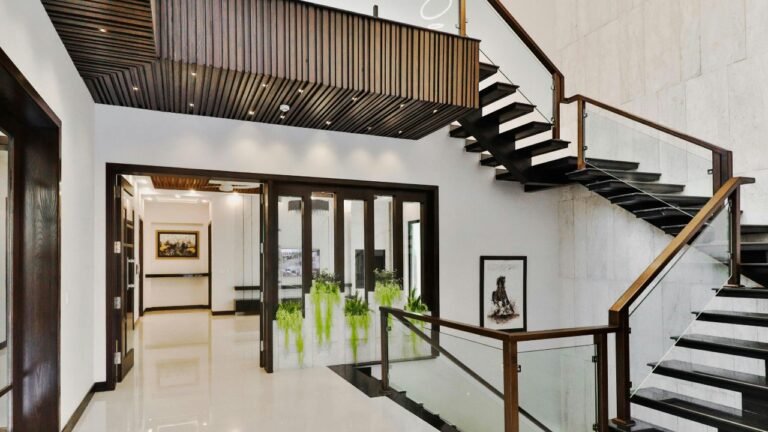22 Layering Textures for a Cozy Yet Elevated Look

Creating a home that feels warm, inviting, and elevated is not only about color or furniture placement—it’s about layering textures. When done right, textures transform a room from flat and predictable into something that feels alive, personal, and stylish. Think about the way a chunky knit throw makes a sofa more approachable, or how a sleek marble table adds sophistication next to a soft rug. Texture is the secret ingredient that connects comfort and elegance in any space.
In this article, I’ll walk you through 22 layering texture ideas that work beautifully for cozy yet elevated interiors. These tips are practical, relatable, and easy to bring into your own home. Whether you’re decorating a living room, bedroom, or entryway, these ideas will help you style with depth and warmth.
In This Article
- 1 1. Start with a Neutral Fabric Base
- 2 2. Add Chunky Knit Throws
- 3 3. Use Layered Rugs
- 4 4. Mix Leather with Soft Fabrics
- 5 5. Introduce Velvet Accents
- 6 6. Use Faux Fur for Warmth
- 7 7. Pair Metal with Soft Textiles
- 8 8. Layer Wood Finishes
- 9 9. Add Woven Baskets
- 10 10. Mix Glossy and Matte Surfaces
- 11 11. Play with Glass and Stone
- 12 12. Incorporate Shearling Accents
- 13 13. Balance Linen with Silk
- 14 14. Use Stoneware Accessories
- 15 15. Mix Patterned and Solid Fabrics
- 16 16. Incorporate Rattan and Cane
- 17 17. Layer Curtains and Blinds
- 18 18. Use Quilted Details
- 19 19. Add Ceramic and Clay Pieces
- 20 20. Balance Smooth and Rough Finishes
- 21 21. Incorporate Greenery for Organic Texture
- 22 22. Finish with Layered Lighting
1. Start with a Neutral Fabric Base
The first step to layering textures is choosing a calm foundation. Sofas, chairs, and bedding in neutral fabrics—linen, cotton, or wool—set the stage. A neutral base acts like a blank canvas, letting you add layers without overwhelming the space. I once bought a beige linen sofa, and while it felt plain at first, it turned into the perfect backdrop for patterned throws and velvet pillows. Neutral tones keep the look grounded while letting other textures shine.
2. Add Chunky Knit Throws
Nothing says cozy like a chunky knit. Drape one across a sofa or at the foot of your bed. The oversized loops create instant warmth, almost like giving the room a hug. Knits pair beautifully with smooth materials like leather or linen. I always keep one nearby during winter—it feels like wrapping yourself in comfort while adding visual depth to the space.
3. Use Layered Rugs
Rugs are the quickest way to ground a room. Instead of just one, try layering a patterned rug over a larger natural fiber base like jute or sisal. The contrast between the rough jute and the soft patterned wool creates dimension. I tried this in my living room, and it instantly made the space feel curated, like something out of a design magazine.
4. Mix Leather with Soft Fabrics
Leather brings structure and elegance, while soft fabrics balance its coolness. A leather armchair next to a velvet pillow or wool throw creates harmony. The key is balance—too much leather feels stiff, but mixed with softer textures, it feels timeless. My brown leather chair only felt “finished” once I placed a cream knit throw on it.
5. Introduce Velvet Accents
Velvet is luxurious, but it doesn’t have to feel formal. A few velvet cushions or an ottoman can bring richness to a casual space. The way velvet reflects light gives depth to colors, making them appear more vibrant. A navy velvet pillow on a beige sofa, for instance, feels both cozy and elevated.
6. Use Faux Fur for Warmth
Faux fur instantly adds a sense of indulgence. Whether it’s a rug by the bed or a fur throw on an armchair, it brings warmth and comfort. I once placed a faux fur pillow on my reading chair, and it quickly became my favorite corner—it felt like luxury without being intimidating.
7. Pair Metal with Soft Textiles
Shiny metals—like brass, gold, or chrome—can feel cold on their own. But paired with soft textiles, they create balance. A brass lamp on a wooden side table with a linen shade feels chic. Or picture a gold-framed mirror above a fabric-covered console—glamorous yet approachable.
8. Layer Wood Finishes
Wood adds natural warmth, but using just one finish can feel flat. Layering different tones—like light oak with walnut or rustic reclaimed wood with polished finishes—creates visual interest. My dining room came to life when I mixed a walnut table with lighter oak chairs. It felt intentional instead of matched from a catalog.
9. Add Woven Baskets
Woven baskets bring in a handmade, organic feel. They’re perfect for storing blankets, magazines, or plants. I like placing one next to the sofa—it keeps clutter hidden but also adds texture. Their natural fibers break up sleek surfaces and make a room feel lived-in.
10. Mix Glossy and Matte Surfaces
Contrast glossy finishes with matte ones for a modern, layered effect. A glossy marble tray on a matte wooden table looks sophisticated. Even small touches—like matte black hardware paired with glossy subway tiles—make a difference. This mix keeps the eye moving and prevents a space from feeling one-dimensional.
11. Play with Glass and Stone
Glass adds airiness, while stone grounds the space. Together, they create balance. Think of a glass vase on a stone mantel, or a marble-topped coffee table with glass accessories. In my kitchen, I placed glass jars on a stone countertop, and the mix made the space feel fresh yet timeless.
12. Incorporate Shearling Accents
Shearling is cozy yet modern. A shearling stool, accent chair, or even a pillow adds softness that feels chic. The tactile texture invites touch, making spaces warmer. I once added a shearling cushion to a wooden bench, and suddenly the bench wasn’t just seating—it became a design moment.
13. Balance Linen with Silk
Linen feels casual, while silk feels refined. Mixing them adds an elegant yet approachable vibe. A linen duvet with silk accent pillows is a perfect example. The matte look of linen makes the glossy silk shine brighter, creating harmony.
14. Use Stoneware Accessories
Stoneware bowls, vases, or planters bring rustic charm and weight to a room. Their raw finish contrasts beautifully with smoother materials like glass or polished wood. I keep a stoneware vase on my console, and it anchors the space while holding fresh greenery.
15. Mix Patterned and Solid Fabrics
Patterns add energy, while solids keep balance. A patterned pillow next to a plain one is an easy way to layer. I once combined a striped throw with solid cushions, and the room felt dynamic yet cohesive. Too many patterns overwhelm, but when paired with solids, they shine.
16. Incorporate Rattan and Cane
Rattan and cane bring a breezy, organic texture. They work especially well in dining chairs, side tables, or headboards. Their open weave lightens up heavier materials. I added a cane chair to my desk area, and suddenly the corner felt less rigid and more inviting.
17. Layer Curtains and Blinds
Windows are an overlooked spot for texture. Pairing fabric curtains with bamboo blinds or Roman shades adds depth. The layered look not only improves privacy but also creates softness. I once swapped plain blinds for this combo, and it instantly transformed the room’s atmosphere.
18. Use Quilted Details
Quilted fabrics, whether in bedspreads, ottomans, or pillows, add a tactile layer. The stitched patterns break up flat surfaces and bring subtle detail. My quilted bedspread feels cozy but still tailored—perfect for a relaxed yet elevated bedroom.
19. Add Ceramic and Clay Pieces
Handmade ceramics and clay pots bring authenticity to a room. Their imperfections are what make them beautiful. A ceramic lamp or clay planter adds an artisanal touch that feels grounding. I treasure a clay bowl I bought at a local market—it always sparks conversation.
20. Balance Smooth and Rough Finishes
Design thrives on contrast. Smooth finishes like glass, marble, or polished wood feel elevated, while rough finishes like raw stone or distressed wood feel earthy. When you put them together, you get harmony. For example, a polished marble tray on a rustic wooden table strikes the perfect balance.
21. Incorporate Greenery for Organic Texture
Plants add living texture. Their leaves—glossy, spiky, or trailing—add layers no fabric can replicate. Pairing greenery with woven baskets or ceramic pots enhances the effect. My monstera plant, sitting in a clay pot, has become the centerpiece of my living room—it adds life and softness all at once.
22. Finish with Layered Lighting
Lighting isn’t just functional; it’s textural. Mix different types: a fabric shade lamp, a metal floor lamp, and a glass pendant. Each material reflects light differently, creating mood and depth. When I layered lighting in my living room, the space shifted from flat to cozy and elevated with just a flick of a switch.
Final Thoughts
Layering textures is like telling a story through touch. Each material has a voice—soft, sleek, rough, or glossy—and together they create harmony. The beauty of texture is how it makes a home feel human, not staged. By mixing and layering thoughtfully, you’ll achieve a space that is not only cozy yet elevated but also deeply personal.
So next time you look around your room, ask yourself: what textures can I add or layer to make it feel alive? Even one change—a knit throw, a velvet pillow, or a woven basket—can shift the whole atmosphere.






